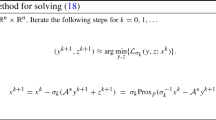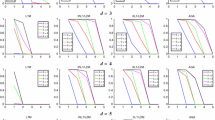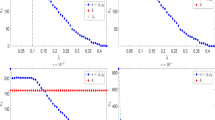Abstract
We show that the A-optimal design optimization problem over m design points in \({\mathbb {R}}^n\) is equivalent to minimizing a quadratic function plus a group lasso sparsity inducing term over \(n\times m\) real matrices. This observation allows to describe several new algorithms for A-optimal design based on splitting and block coordinate decomposition. These techniques are well known and proved powerful to treat large scale problems in machine learning and signal processing communities. The proposed algorithms come with rigorous convergence guarantees and convergence rate estimate stemming from the optimization literature. Performances are illustrated on synthetic benchmarks and compared to existing methods for solving the optimal design problem.


Similar content being viewed by others
Change history
12 September 2019
Unfortunately, due to a technical error, the articles published in issues 60:2 and 60:3 received incorrect pagination. Please find here the corrected Tables of Contents. We apologize to the authors of the articles and the readers.
Notes
When \(\mu \) is the uniform measure over the design space, we point out that the IMSE criterion is sometimes called I-optimality, or IV-optimality (for integrated variance); see Pukelsheim (1993).
References
Atkinson A, Donev A (1992) Optimum experimental designs. Oxford Statistical Science Series, vol 8. Oxford University Press, Oxford
Bach F (2008) Consistency of the group lasso and multiple kernel learning. J Mach Learn Res 9:1179–1225 (Jun)
Bach F, Jenatton R, Mairal J, Obozinski G (2012) Optimization with sparsity-inducing penalties. Found Trends Mach Learn 4(1):1–106
Beck A, Teboulle M (2009) A fast iterative shrinkage-thresholding algorithm for linear inverse problems. SIAM J Imaging Sci 2(1):183–202
Beck A, Pauwels E, Sabach S (2015) The cyclic block conditional gradient method for convex optimization problems. SIAM J Optim 25(4):2024–2049
Bertsekas DP (1999) Nonlinear programming, 2nd edn. Athena Scientific, Belmont
Böhning D (1986) A vertex-exchange-method in D-optimal design theory. Metrika 33(1):337–347
Borwein J, Lewis AS (2010) Convex analysis and nonlinear optimization: theory and examples. Springer, New York
Boyd S, Vandenberghe L (2004) Convex optimization. Cambridge University Press, Cambridge
Braun G, Pokutta S, Zink D (2017) Lazifying conditional gradient algorithms. In: International conference on machine learning, pp 566–575
Černỳ M, Hladík M (2012) Two complexity results on c-optimality in experimental design. Comput Optim Appl 51(3):1397–1408
Chaloner K (1984) Optimal Bayesian experimental design for linear models. Ann Stat 12:283–300
Chambolle A, Dossal C (2015) On the convergence of the iterates of “FISTA”. J Optim Theory Appl 166(3):25
Combettes PL, Pesquet JC (2011) Proximal splitting methods in signal processing. In: Fixed-point algorithms for inverse problems in science and engineering, pp 185–212. Springer, New York
Duncan G, DeGroot M (1976) A mean squared error approach to optimal design theory. In: Proceedings of the 1976 conference on Information: science and systems, pp 217–221. The John Hopkins University, Baltimore
Fedorov V (1972) Theory of optimal experiments. Academic Press, New York. Translated and edited by W. J. Studden and E.M. Klimko
Fedorov V (1996) Design of spatial experiments: model fitting and prediction. In: Gosh S, Rao C (eds) Handbook of statistics, Chap. 16, vol 13. Elsevier, New York, pp 515–553
Fedorov V, Lee J (2000) Design of experiments in statistics. In: Wolkowicz H, Saigal R, Vandenberghe L (eds) Handbook of semidefinite programming. Kluwer, Boston
Frank M, Wolfe P (1956) An algorithm for quadratic programming. Naval Res Logist Q 3(1–2):95–110
Gauthier B, Pronzato L (2016) Optimal design for prediction in random field models via covariance kernel expansions. In: mODa 11-advances in model-oriented design and analysis, pp 103–111. Springer
Gauthier B, Pronzato L (2017) Convex relaxation for imse optimal design in random-field models. Comput Stat Data Anal 113:375–394
Harman R, Filová L, Richtárik P (2018) A randomized exchange algorithm for computing optimal approximate designs of experiments . arXiv:1801.05661
Kerdreux T, Pedregosa F, d’Aspremont A (2018) Frank-Wolfe with subsampling oracle. arXiv:1803.07348
Lukemire J, Mandal A, Wong W (2018) D-QPSO: a quantum-behaved particle swarm technique for finding d-optimal designs with discrete and continuous factors and a binary response. In: Technometrics, pp 1–27
Nesterov Y (1983) A method of solving a convex programming problem with convergence rate O (1/k2). Sov Math Dokl 27:372–376
Pilz J (1983) Bayesian estimation and experimental design in linear regression models, vol 55. Teubner-Texte zur Mathematik, Leipzig
Pronzato L (2013) A delimitation of the support of optimal designs for kiefer’s \(\phi \)p-class of criteria. Stat Probab Lett 83(12):2721–2728
Pukelsheim F (1993) Optimal design of experiments. Wiley, New York
Pukelsheim F, Rieder S (1992) Efficient rounding of approximate designs. Biometrika 79:763–770
Rockafellar RT (1970) Convex analysis. Princeton Mathematical Series, vol 28. Princeton University Press, Princeton
Rockafellar RT, Wets RJB (2009) Variational analysis, vol 317. Springer, New York
Sagnol G (2011) Computing optimal designs of multiresponse experiments reduces to second-order cone programming. J Stat Plan Inference 141(5):1684–1708
Sagnol G, Harman R (2015) Computing exact D-optimal designs by mixed integer second-order cone programming. Ann Stat 43(5):2198–2224
Sagnol G, Hege H.C, Weiser M (2016) Using sparse kernels to design computer experiments with tunable precision. In: Proceedings of the 22nd international conference on computational statistics, pp 397–408
Silvey S, Titterington D, Torsney B (1978) An algorithm for optimal designs on a finite design space. Commun Stat Theory Methods 7(14):1379–1389
Spöck G, Pilz J (2010) Spatial sampling design and covariance-robust minimax prediction based on convex design ideas. Stoch Environ Res Risk Assess 24(3):463–482
Tanaka K, Miyakawa M (2013) The group lasso for design of experiments. arXiv:1308.1196
Wright SJ (2015) Coordinate descent algorithms. Math Progr 151(1):3–34
Wynn H (1970) The sequential generation of \(D\)-optimum experimental designs. Ann Math Stat 41:1655–1664
Yu Y (2010) Monotonic convergence of a general algorithm for computing optimal designs. Ann Stat 38(3):1593–1606
Yu Y (2011) D-optimal designs via a cocktail algorithm. Stat Comput 21(4):475–481
Yuan M, Lin Y (2006) Model selection and estimation in regression with grouped variables. J R Stat Soc B 68(1):49–67
Acknowledgements
Both authors would like to thank two anonymous reviewers for their careful reading and detailed comments which helped improve the quality of this manuscript.
Author information
Authors and Affiliations
Corresponding author
Additional information
This work was initiated when the first author was invited in Toulouse by the Chair in Applied Mathematics OQUAIDO, gathering partners in technological research (BRGM, CEA, IFPEN, IRSN, Safran, Storengy) and academia (CNRS, Ecole Centrale de Lyon, Mines Saint-Etienne, University of Grenoble, University of Nice, University of Toulouse) around advanced methods for Computer Experiments. The research of the first author is carried out in the framework of MATHEON supported by Einstein Foundation Berlin.
Rights and permissions
About this article
Cite this article
Sagnol, G., Pauwels, E. An unexpected connection between Bayes A-optimal designs and the group lasso. Stat Papers 60, 565–584 (2019). https://doi.org/10.1007/s00362-018-01062-y
Received:
Revised:
Published:
Issue Date:
DOI: https://doi.org/10.1007/s00362-018-01062-y




